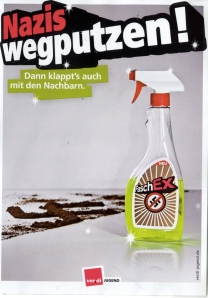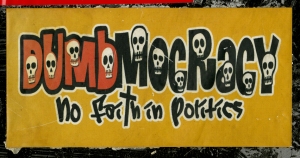“WTF. It’s only a sticker.”
- Published
- in Berlin
My paper proposal, “WTF. It’s only a sticker.” was accepted for a panel at the annual College Art Association conference in 2012. The panel, chaired by artist Wendy DesChene, is called “Disrupt this Session: Rebellion in Art Practices Today.” Here is my proposal below along with my Tedford CAA 2012 Proposal PDF.
______________________________________
Street art stickers, a form of post-graffiti, are now ubiquitous in the urban environment, and sticker culture permeates the Web on listservs, blogs, Flickr, etc. One listserv from PEEL Magazine called SLAPS Stickerhead Forum shows a thread from Tony, who writes, “who the fuck has time to do all this stuff? wheat paste over sticker? cut them up? put a clear coat over? for fuck’s sake it’s a sticker who gives a shit.” Stuntman replies, “that’s what I was thinking, its only a sticker” (sic).
Little Black Cart, a bookstore and Web site devoted to “the total transformation of society,” describes the international Situationist movement as being characterized by a “healthy opposition to ideologies.” This healthy opposition is readily apparent in the multitude of street art stickers and ephemera that say “fuck you” in one way or another to various forms of authority or oppressive control, whether it be the government, the police, the “Man,” Wal-mart, the rich, mass media, one’s boss, neo-Nazis, fascists, male or female, dead or alive.
Using primary examples drawn from my personal collection of over 3,000 stickers, I will compare and contrast how rebellion and resistance are represented in political stickers from New York City and Berlin since 2003. Topics run the gamut, including civil liberties, urban development, environmental degradation, right-wing extremism, and the war on terror, among others. Small stickers. Vast subjects.
Sticker artists utilize a range of rhetorical strategies in their public critique of society, from humor and hooliganism to militant resistance and anarchy. Some stickers shout. Others whisper. One U.S. sticker shows a portrait of Sarah Palin with “Trojan Horse” written below. Another simple office folder label suggests, “I don’t think we have the budget for this,” in tiny handwritten cursive. A new font was designed for “DUMBMOCRACY: no faith in politics,” with floating skulls bobbing amidst the words.
More militant stickers (these from Berlin) have Trinity from The Matrix pointing the mean end of a pistol’s extended barrel toward us at eye level, and “Gegen Sexismus und Homophobie; verpiss dich macker,” or “Against sexism and homophobia; piss off.” Another sticker reads, “If the kids are united, they will never be divided,” with cartoon punks standing in front of a hooded figure photographed throwing a lit Molotov cocktail, and the acronym ACAB, which stands for “all cops are bastards.” “Freiheit statt Angst: Stoppt den Überwachungswahn” advertises a demonstration for “Freedom not Fear: Stop the Surveillance Mania” in 2009, which drew thousands of people from across Germany to protest newly enacted laws and policies created by the European Union regarding government monitoring and data control.
Comparatively speaking, stickers from Germany reflect a citizenry that is more actively engaged in political dissent and at times through anger and violence. One could argue that post-WWII Berlin, and especially the former east Berlin, still operates as a police state, with frequent public protests and demonstrations showing armed riot police in head-on clashes with unarmed protesters and passersby. These events are rarely documented in mainstream media, but easy to find on YouTube and other social media. In Berlin, stickers and street art in general call for participation.
In contrast, political stickers are found in the United States, of course, but the rhetoric is markedly different. Not surprisingly, most of the stickers in New York City focus on entertainment and consumption, and attempts to affect social change through opposition and critique inevitably become absorbed by corporate America.



